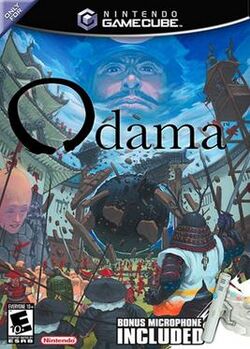Odama
Topic: Software
 From HandWiki - Reading time: 4 min
From HandWiki - Reading time: 4 min
| Odama | |
|---|---|
 North American box art | |
| Developer(s) | Vivarium |
| Publisher(s) | Nintendo |
| Director(s) | Keiji Okayasu |
| Producer(s) | Yoot Saito |
| Designer(s) | Yoot Saito Takuya Jinda |
| Programmer(s) | Shintarou Kawahara Kanta Kobayashi Tsuyoshi Inada Takuya Oba |
| Platform(s) | GameCube |
| Release | |
| Genre(s) | Pinball, real-time tactics |
| Mode(s) | Single-player |
Odama[lower-alpha 1] is a video game for the GameCube developed by Vivarium and published by Nintendo in 2006. The game was produced and designed by Seaman creator, Yutaka Saito. It is the penultimate GameCube game to be published by Nintendo, followed by The Legend of Zelda.
Odama blends tactical wargaming with pinball gameplay. The game takes place in a feudal Japan setting. The main character is a young general named Yamanouchi Kagetora, who is intent on avenging his father's death by reviving the most ingenious weapon ever to hit the medieval battlefield: the Odama. The Odama is a gigantic ball powerful enough to destroy whatever it strikes, friend or foe. Using giant flippers, players aim the Odama to bowl over enemies, shatter their defenses and wreak havoc on the battlefield. With the GameCube Microphone, players direct their soldiers out of the Odama's way and into the fray by charging the enemy, defending positions and seizing the enemy gates.
Plot
The main character in Odama is Yamanouchi Kagetora, a young general struggling to avenge his clan and preserve the Way of Ninten-do, which is a philosophy that means "The way of heavenly duty". With this philosophy to guide him, he finds that his individual soldiers can band together to create a force strong enough to defeat even the most powerful enemy, a general named Karasuma Genshin. Genshin betrayed Lord Yamanouchi Nobutada, Kagetora's father, in a coup, leading Lord Nobutada to take his own life in order to avoid the shame of defeat. Kagetora exacts his revenge, using only limited resources against a vast army. One of these resources is a sacred object protected by his clan: a legendary weapon called the Odama.
Gameplay
The player controls flippers, which operate exactly like those in a pinball game: they strike the Odama back into the battlefield, directing it into targets and away from soldiers. Between the two flippers, the commander stands guard, hacking down any soldiers who attempt to pass. Players can tilt the battlefield, allowing them to alter the course of the Odama. The goal is to shatter the enemy gates with the Odama and direct a crew of men carrying a giant bell to pass through the opened gates. Players' soldiers will defend their crew and seize enemy positions to protect their men on the mission.
The GameCube Microphone was included with the game. Using the Microphone, players direct soldiers by giving voice commands. There are 11 commands, ranging from generic (moving left and right, advancing and retreating) to map-specific and special moves.
Development
Odama was developed by Vivarium Inc. and chiefly designed by Yoot Saito, the creator of Seaman for the Dreamcast.[2][3] According to Nintendo producer Shigeru Miyamoto, the publisher was initially taken aback by the game's curious mix of pinball and real-time tactics and Saito's initial pitch, "I want to make a pinball game set in feudal Japan." However, Saito eventually convinced them after creating a demo of the game.[2]
Odama debuted at the Electronic Entertainment Expo (E3) in 2004. This version of the game showcased the use of the DK Bongos, which allowed a second player to raise troop morale and distract enemy troops by repeatedly beating the drums.[4] However, this feature was absent from its E3 showing the next year and dropped prior to the game's release.[3]
Reception
| Reception | ||||||||||||||||||||||||||||||||||||||||
|---|---|---|---|---|---|---|---|---|---|---|---|---|---|---|---|---|---|---|---|---|---|---|---|---|---|---|---|---|---|---|---|---|---|---|---|---|---|---|---|---|
| ||||||||||||||||||||||||||||||||||||||||
| ||||||||||||||||||||||||||||||||||||||||
The game received "mixed" reviews according to video game review aggregator Metacritic.[5] In Japan, Famitsu gave it a score of three eights and one seven for a total of 31 out of 40.[9]
Odama won IGN's Most Innovative Design for a GameCube game in 2006.[21]
References
- ↑ "Odama Released - Press Release". http://www.nintendoworldreport.com/pr/11278/odama-released.
- ↑ 2.0 2.1 Gibson, Ellie (January 6, 2006). "Miyamoto talks Odama". http://www.eurogamer.net/articles/news060106miyamoto.
- ↑ 3.0 3.1 Dormer, Dan (January 13, 2006). "Odama Gets Release Date". http://www.1up.com/news/odama-release-date.
- ↑ IGN Staff (May 11, 2004). "E3 2004: Odama Unveiled". http://www.ign.com/articles/2004/05/12/e3-2004-odama-unveiled.
- ↑ 5.0 5.1 "Odama for GameCube Reviews". https://www.metacritic.com/game/odama/critic-reviews/?platform=gamecube.
- ↑ Edge staff (May 2006). "Odama". Edge (162): 90.
- ↑ EGM staff (June 2006). "Odama". Electronic Gaming Monthly (204): 119.
- ↑ Bramwell, Tom (March 31, 2006). "Odama". http://www.eurogamer.net/articles/r_odama_gc.
- ↑ 9.0 9.1 Riley, Adam (April 6, 2006). "Famitsu Rates Odama & Legend of Stafi". Cubed. http://www.cubed3.com/news/4880/1/nintendo-reviews-famitsu-rates-odama-and-legend-of-stafi.html.
- ↑ Miller, Matt (March 2006). "Odama". Game Informer (155): 112. http://www.gameinformer.com/NR/exeres/0D68CE06-1497-454A-9FBD-E9084D5A3B86.htm. Retrieved January 16, 2016.
- ↑ Long Haired Offender (April 10, 2006). "Review: Odama". GamePro. http://gamepro.com/nintendo/gamecube/games/reviews/53240.shtml. Retrieved January 16, 2016.
- ↑ Dodson, Joe (April 21, 2006). "Odama Review". Game Revolution. http://www.gamerevolution.com/review/odama.
- ↑ Davis, Ryan (April 11, 2006). "Odama Review". http://www.gamespot.com/reviews/odama-review/1900-6147488/.
- ↑ Williams, Bryn (April 11, 2006). "GameSpy: Odama". GameSpy. http://cube.gamespy.com/gamecube/odama/701217p1.html.
- ↑ "Yoot Saito's Odama [sic Review Text"]. GameTrailers. April 11, 2006. http://www.gametrailers.com/reviews/ubanqu/yoot-saito-s-odama-review.
- ↑ Aceinet (May 4, 2006). "Odama - GC - Review". GameZone. http://www.gamezone.com/reviews/odama_gc_review.
- ↑ Casamassina, Matt (April 11, 2006). "Odama". http://www.ign.com/articles/2006/04/11/odama.
- ↑ "Odama". Nintendo Power 203: 92. May 2006.
- ↑ Modell, Josh (May 10, 2006). "Odama". The A.V. Club. http://www.avclub.com/article/odama-9026.
- ↑ Schaefer, Jim (April 29, 2006). "Squash the Samurai". Detroit Free Press. http://www.freep.com/apps/pbcs.dll/article?AID=/20060430/ENT06/604300319/1044.
- ↑ 21.0 21.1 "Best of 2006: Most Innovative Design (GameCube)". http://bestof.ign.com/2006/cube/31.html.
Notes
- ↑ Odama (大玉 Ōdama, lit. "Great Ball")
External links
 |
 KSF
KSF